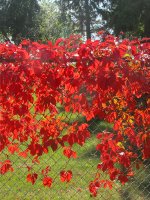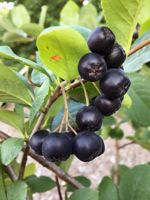Mon-Fri 9am - 5pm Mountain time
Virginia Creeper vs Aronia Berry
Parthenocissus quinquefolia
Aronia melanocarpa
NOT AVAILABLE THIS SEASON - MIGHT RETURN
Virginia Creeper is a fast-growing, climbing vine. Its root-like tendrils attach themselves to any non-smooth surface, even brick, but will also grow as a ground cover.
Virginia Creeper makes a beautiful ornamental plant for your garden; its attractive foliage turns from green to deep red in the fall. Birds will love its red berries.
Aronia Berry produces black fruit that is often considered too astringent. This is why they are also referred to as Black Chokeberry. It is native to Eastern Canada and the Eastern United States. White to pink flowers appear in the spring which provides a nice contrast to the dark green foliage. In fall the leaves turn a vibrant orange to red.
It has a fast growth rate, strong roots, and can tolerate growing in wet soils. This makes it well suited for various projects including forming hedges, bank stabilization, erosion control, and in wetter riparian areas. They are also well suited as an understory plant as it grows well under other trees.
Aronia berries have their own unique flavour. The polyphenols and anthocyanins are touted as healthy antioxidants and lots of research seems to be underway on the health benefits of this fruit.
Virginia Creeper Quick Facts
Aronia Berry Quick Facts
Toxicity: berries are toxic

